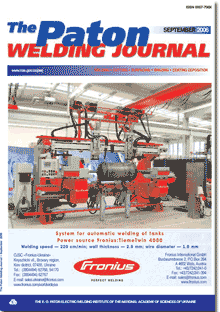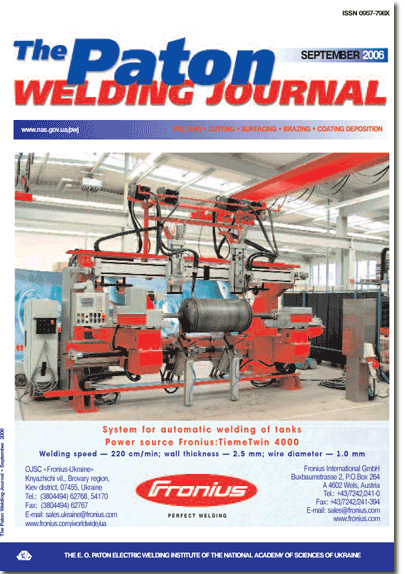

| SCIENTIFIC AND TECHNICAL | |
| Lobanov L.M., Kirian V.I., Knysh V.V. and ProkopenkoG.I. Improvement of fatigue resistance of welded joints in metal structures by high-frequency mechanical peening (Review) | 2 |
| Results of studying the effectiveness of application of high-frequency mechanical peening (HFMP) to improve the fatigue resistance of welded joints on steels of different strength classes and aluminium alloys have been generalized. General regularities are established of variation of fatigue resistance of welded joints as a result of HFMP, determined by the mechanical properties of the material, level of concentration of working stresses, asymmetry of external loading cycle, magnitude and sign of the residual stresses induced by treatment in the concentrator zone. A procedure is developed for calculation-based prediction of the effectiveness of HFMP, depending on the above factors. | |
| Gretsky Yu.Ya. Main aspects of weldability of structural cast irons | 9 |
| The role of composition, structure and mechanical properties of cast iron castings are considered from the view point of welding. The main factors are named, which determine considerable difficulties in making the composite readily workable welded joints in welding cast iron products without high preheating or subsequent heat treatment. The influence of the graphite phase and metal base oxidation products on the basic possibility of cast iron to form a welded joint is considered. Conditions of solidification and structure formation in the fusion zone are analyzed. Results of studying the influence of the thermal cycle of arc welding on the structure and properties of cast irons in the HAZ metal are analyzed. The concepts of the nature of near-weld cracks are presented, and the principles of prevention of tears and microcracks in the HAZ metal are set forth. The initial postulates for selection of the composition of the deposited metal and respective electrode consumables, and measures for lowering the susceptibility of nickel-based weld metal to pore formation are presented. A set of requirements to the quality of arc welding of cast iron is determined, and metallurgical and technological measures for ensuring the continuity, tightness, strength and treatability of welded joints are generalized. | |
| Skulsky V.Yu. Effect of the degree of alloying of heat-resistant chromium steels on hardness of metal within the welded joint zone | 17 |
| Considered is relationship between the degree of alloying of heat-resistant chromium steels (with 2.25Д13 % Cr), martensite transformation temperature Ms and resultant hardness of the hardened metal of welded joints. It is shown that the level of hardness depends upon temperature Ms, and is related to the time of self-tempering of martensite at the stage of metal cooling from the transformation temperature. | |
| Shonin V.A., Mashin V.S., Khaskin V.Yu. and NedejT.N. Residual stresses in butt joints of thin sheets from alloy AMg6 after arc and laser-arc welding | 20 |
| Results of experimental study of residual strains and stresses in butt joints of thin sheets from alloy AMg6 having thickness 1.9 mm made by MIG and MIG + laser welding are reported. It is established that a six-fold increase of the welding speed (hybrid process) provides a two-fold narrowing of the weld cross-section, one-and-a-half times narrowing of the HAZ with longitudinal residual stresses, and more than four-fold reduction of the transverse residual stresses. | |
| Denisevich E.A. Calculation technique for defining parameters of soldered seam solidification | 25 |
| Described is the technique of defining the condition of stability of flat solidification front of soldered seams on copper М1 with self-fluxing solder on the basis of SnДPbДBi system low-melting alloy and surfactants as fluxing components of the soldering composition. Solidification is the final stage of soldered seam formation and their service characteristics depend on conditions of its proceeding in soldered joints. Studying the process of solidification of soldered seams by calculations opens up opportunities for forecasting technological parameters of soldering processes. The characteristics obtained as a result of calculation enable to adjust technological conditions of soldering in order to improve service characteristics of soldered joints. | |
| Ulshin V.A., Kharlamov M.Yu., Borisov Yu.S. and Astakhov E.A. Dynamics of movement and heating of powder in detonation spraying of coatings | 29 |
| Mathematical model is suggested, describing interaction of powder particles with detonation products inside the channel of a detonation unit and in the space between an exit section of the channel and a workpiece. Calculation and experimental results are compared. Peculiarities of behaviour of powder particles in detonation spraying are numerically studied. | |
| INDUSTRIAL | |
| Lankin Yu.N., Moskalenko A.A., Tyukalov V.G., KuranR.I. and Popov S.V. Electroslag welding of blast furnace housing | 35 |
| Selection of the electroslag welding process for making vertical butt joints of the shells of DP-5 blast furnace housing in Enakievo Metallurgical Works is substantiated. Mechanical properties of the joint metal of 09G2S steel 40Д50 mm thick made by electroslag welding with concurrent cooling are given. Technological sequence of assembly and welding with application of site welding equipment AD-381 is described. | |
| Poznyakov V.D., Kasatkin S.B. and Dovzhenko V.A. Structure and cold resistance of welded joints in steel 09G2S after repair welding | 37 |
| Structure and impact toughness of weld and HAZ metal in steel 09G2S under conditions of primary (manufacturing) and repair arc welding are compared. Recommendations are given for selection of welding consumables, taking into account service conditions of repaired items. | |
| Klimpel A., Lisiecki A., Janicki D. and Stano S. High power diode laser welding of aluminum alloy ENAW-1050A | 43 |
| In this work, results of study on the process of high-power diode laser (HPDL) welding of aluminum alloy AW-1050A are presented. Butt joints of thin aluminum sheets were produced using HPDL ROFIN SINAR DL 020. The influence of welding procedure on mechanical properties and microstructure of welded joints were determined. It was proved that it is possible to produce high quality joints in a wide range of laser welding parameters. | |
| BRIEF INFORMATION | |
| Kozulin S.M., Sushchuk-Slyusarenko I.I. and LychkoI.I. Influence of ESC parameters on the quality of reconditioned gear teeth | 47 |
| Influence of the parameters of electroslag cladding on the penetration depth and thickness of skull crust was studied at reconditioning of the teeth of large-pitch gears by electroslag cladding. The obtained regression dependencies were used to plot the nomograms for establishing a quantitative relationship between the individual parameters of the mode. | |
| Cooperation raises investigation efficiency and reduces costs | 50 |
| Developed at PWI | 46 51 52 |
(You are viewing the simplified file contents)
The cost of subscription/purchase order journals or individual articles
| Journal/Currency | Annual Set | 1 issue printed |
1 issue |
one article |
| TPWJ/USD | 384 $ | 32 $ | 26 $ | 13 $ |
| TPWJ/EUR | 348 € | 29 € | 24 € | 12 € |
| TPWJ/UAH | 7200 UAH | 600 UAH | 600 UAH | 280 UAH |
| AS/UAH | 1800 UAH | 300 UAH | 300 UAH | 150 UAH |
| AS/USD | 192 $ | 32 $ | 26 $ | 13 $ |
| AS/EUR | 180 € | 30 € | 25 € | 12 € |
| SEM/UAH | 1200 UAH | 300 UAH | 300 UAH | 150 UAH |
| SEM/USD | 128 $ | 32 $ | 26 $ | 13 $ |
| SEM/EUR | 120 € | 30 € | 25 € | 12 € |
| TDNK/UAH | 1200 UAH | 300 UAH | 300 UAH | 150 UAH |
| TDNK/USD | 128 $ | 32 $ | 26 $ | 13 $ |
| TDNK/EUR | 120 € | 30 € | 25 € | 15 € |
AS = «Automatic Welding» - 6 issues per year;
TPWJ = «PATON WELDING JOURNAL» - 12 issues per year;
SEM = «Electrometallurgy Today» - 4 issues per year;
TDNK = «Technical Diagnostics and Non-Destructive Testing» - 4 issues per year.


